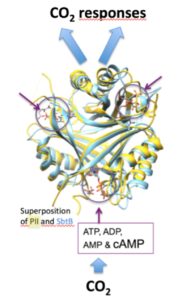Cyanobacteria are oxygenic phototrophs that assimilate CO2 into organic compounds. For CO2 fixation at low ambient concentrations, cyanobacteria evolved a carbon concentrating mechanism that employs high affinity inorganic carbon transporters. Recently, we identified the PII-like protein SbtB as potential CO2-sensing module. Similar to nitrogen-regulatory PII proteins, SbtB is able to bind adenine nucleotides, but unlike these, it binds preferentially the second messenger cAMP. An SbtB-deficient mutant is severely impaired in the acclimation to varying CO2 levels. The modulation of adenylate cyclase activity by bicarbonate has been often discussed as potential carbon-sensing system among cyanobacteria, however, the physiological relevance was enigmatic.
Here, we hypothesize that SbtB represents a new sensor for inorganic carbon availability by responding to the second messenger cAMP. The aim of this proposal is to unravel the second messenger signaling network around SbtB in the cyanobacterial model strain Synechocystis sp. PCC 6803.
Research Project
Linking second messenger nucleotide signalling with CO2 homeostasis in cyanobacteria: unravelling the SbtB-based network


